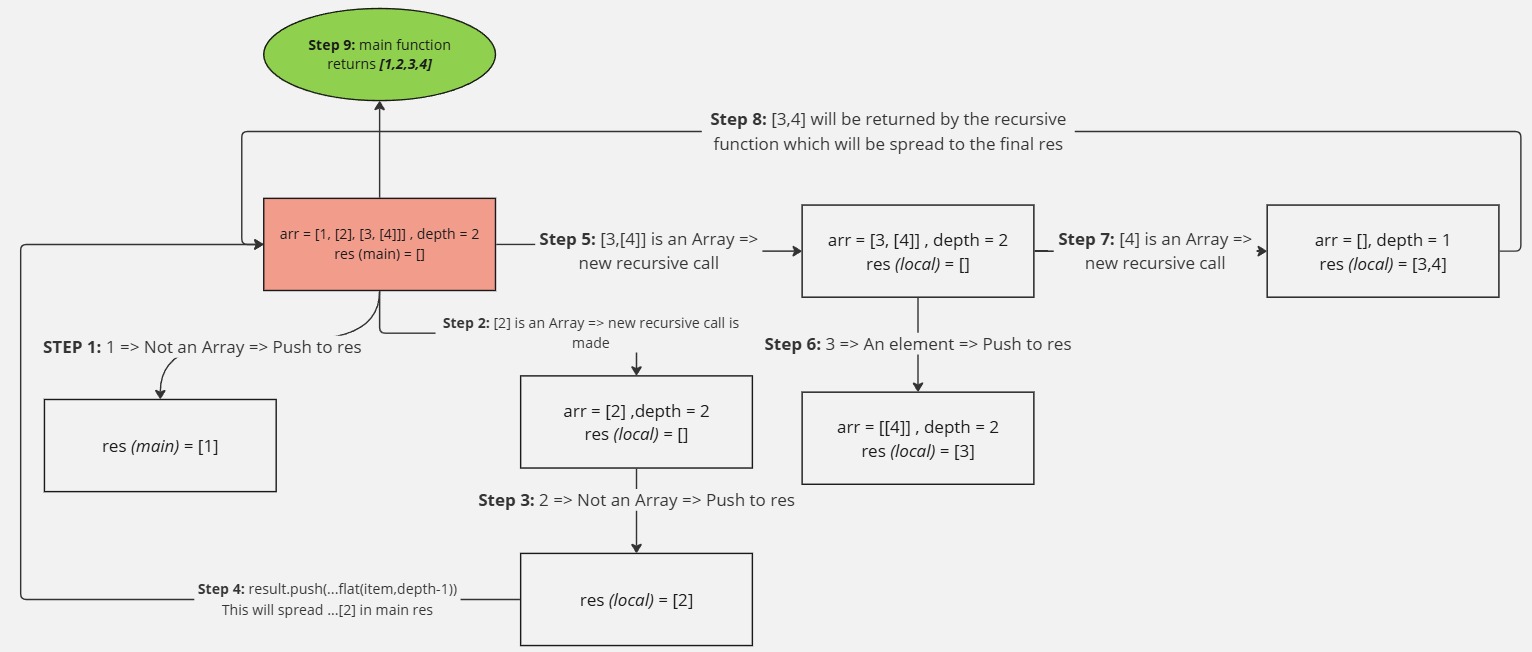Implement Array.prototype.flat()
 Abhishek Shukla
Abhishek Shukla
In this blog we’ll implement one of the tricky JS Array prototype functions which is the flat function
Practice Link: https://bigfrontend.dev/problem/implement-Array-prototype.flat
MDN: https://developer.mozilla.org/en-US/docs/Web/JavaScript/Reference/Global_Objects/Array/flat
What is the flat function?
Flat function recursively (can be done iteratively too) concatenates sub-array elements to the new Array, of specified depth.
Few Examples:
const arr = [0, 1, [2, [3, [4, 5]]]];
console.log(arr.flat());
// output: Array [0, 1, 2, Array [3, Array [4, 5]]]
console.log(arr.flat(2))
// output: Array [0, 1, 2, 3, Array [4, 5]]
console.log(arr.flat(Infinity))
output: [0,1,2,3,4,5] // Infinity will flatten all the nestings
Intuition
We know that flat function works recursively, so for every sub-array element in the array, we’ll spread it to the main result because we need to concatenate the sub-array elements. So 2 keys steps: Recursive Spreading
Steps
Create a
resultarrayIterate through the given array and for each item
If the item is an Array and depth is greater than 0:
make the recursive call to the
flatfunction with this item anddepth -1now spread the returned array, and push to the
resultarray
else, item is a normal element, hence directly push it to the
resultarray
return the
resultarray
function flat(arr, depth = 1) {
const result = [] //Stores the final result of flattening
//V.Imp: for..of would fail on "holes" i.e [12,,,13] because it treates the empty
//holes as undefined and will push undefined to the res
//forEach works because it never invokes the callback function on holes
arr.forEach((item) =>{
//Check if the item is an array and if the depth is greater than 0 ,
//i.e we can flatten this array item
if(Array.isArray(item) && depth > 0){
//Make the recursive call on this item and reduce the depth
//and spread the result that will be returned by the flat function
//and push it to result array
result.push(...flat(item,depth-1))
}
//if the item is not an array, directly push it to the the result array
else result.push(item)
})
return result;
}
I’ve tried and created a flowchart of the recursion flow with an example
I hope it helps clear your understanding, if not , I’ll be readily available to enhance this explanation further
Recursive Flowchart:

I hope the above recursive flowchart gives you a better understanding of how exactly our function works.
And that’s it for today, if you read it till here, let me know if the blogs are lacking in any aspects, be it brevity, clarity or elaboration. I’m open to and passionately look forward to any feedbacks and discussions.
Thank you and wish you a good day ahead.
Leaving you with a quote, as usual :)
“We can only see a short distance ahead, but we can see plenty there that needs to be done.” - Alan Turing
Subscribe to my newsletter
Read articles from Abhishek Shukla directly inside your inbox. Subscribe to the newsletter, and don't miss out.
Written by

Abhishek Shukla
Abhishek Shukla
I am Abhishek Shukla , A Computer Engineer by degree and a Software Engineer by profession. I am a Masters of Engineering student at Concordia University, Montreal in Information Systems Security program. I'm proficient in the JS ecosystem and technologies surrounding it. Here on hashnode I intend to express my learnings. Apart from coding , I seldom go about writing poems making melodies on FL studio :)